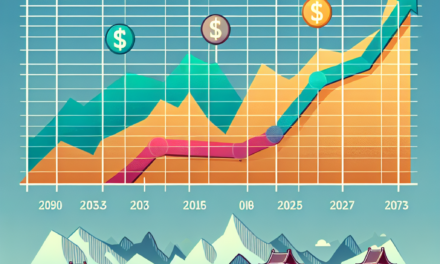“Market Shaken: Bonds Dive to 2020 Lows as Inflation Fears Surge Post-Trump Win”
Introduction
In the wake of Donald Trump’s unexpected victory in the 2016 U.S. presidential election, financial markets experienced significant turbulence, with bond markets particularly affected. Investors, grappling with the potential economic implications of Trump’s proposed policies, reacted swiftly, leading to a sharp decline in bond prices, plunging them to levels not seen since 2020. This dramatic shift was primarily driven by heightened inflation concerns, as market participants anticipated increased fiscal spending, tax cuts, and deregulation under the new administration. These factors were expected to stimulate economic growth but also potentially lead to higher inflation and interest rates, prompting a sell-off in bonds. The resulting surge in bond yields reflected the market’s recalibration to the anticipated economic landscape, underscoring the complex interplay between political developments and financial market dynamics.
Impact Of Inflation Concerns On Bond Markets
The recent plunge in bond markets to levels not seen since 2020 has sparked widespread concern among investors, particularly in the wake of Donald Trump’s unexpected victory. This development has been largely attributed to mounting inflation concerns, which have significantly impacted investor sentiment and market dynamics. As inflation fears intensify, the bond market, traditionally viewed as a safe haven for investors, is experiencing heightened volatility and uncertainty.
To understand the current situation, it is essential to consider the relationship between inflation and bond prices. Bonds are fixed-income securities that pay a set interest rate over time. When inflation rises, the purchasing power of these fixed payments diminishes, making bonds less attractive to investors. Consequently, bond prices tend to fall as inflation expectations increase, leading to higher yields. This inverse relationship between bond prices and yields is a fundamental principle of bond market dynamics.
The recent election outcome has added a layer of complexity to the already volatile economic landscape. Trump’s victory has led to speculation about potential policy changes that could further fuel inflationary pressures. For instance, his proposed fiscal policies, including tax cuts and increased infrastructure spending, are expected to stimulate economic growth. While such measures could boost the economy, they also carry the risk of overheating, thereby exacerbating inflation concerns.
Moreover, the Federal Reserve’s monetary policy stance plays a crucial role in shaping inflation expectations and bond market reactions. The central bank’s decisions regarding interest rates are closely watched by investors, as they directly influence borrowing costs and economic activity. In response to rising inflationary pressures, the Federal Reserve may opt to raise interest rates to curb inflation, which could further impact bond prices. Investors are therefore keenly attuned to any signals from the Federal Reserve regarding its future policy direction.
In addition to domestic factors, global economic conditions also contribute to the current bond market dynamics. Inflationary pressures are not confined to the United States; they are a global phenomenon influenced by supply chain disruptions, rising commodity prices, and geopolitical tensions. These factors have created a challenging environment for central banks worldwide, as they strive to balance economic growth with price stability. Consequently, the interconnectedness of global markets means that developments in one region can have ripple effects across the world, further complicating the bond market landscape.
As investors navigate this uncertain environment, diversification and risk management become increasingly important. While bonds have traditionally been a cornerstone of conservative investment portfolios, the current climate necessitates a reevaluation of strategies. Investors may need to consider alternative asset classes or adjust their bond holdings to mitigate potential losses. Additionally, staying informed about economic indicators and central bank communications can provide valuable insights into future market trends.
In conclusion, the plunge in bond markets to 2020 lows amid inflation concerns following Trump’s victory underscores the complex interplay of economic factors influencing investor behavior. As inflation fears persist, the bond market faces significant challenges, with potential implications for broader financial markets. By understanding the underlying dynamics and remaining vigilant, investors can better navigate this turbulent period and make informed decisions to protect their portfolios.
Analyzing The 2020 Bond Market Plunge
In the wake of the 2020 U.S. presidential election, the bond market experienced a significant downturn, reaching lows not seen since the early months of the year. This decline was largely driven by heightened inflation concerns following Donald Trump’s victory. As investors grappled with the implications of the election outcome, the bond market’s reaction underscored the complex interplay between political events and economic expectations.
To understand the bond market’s plunge, it is essential to consider the broader economic context. During the election period, the U.S. economy was already grappling with the effects of the COVID-19 pandemic, which had prompted unprecedented fiscal and monetary interventions. These measures, while necessary to stabilize the economy, also raised concerns about long-term inflationary pressures. The prospect of a Trump administration, known for its deregulatory stance and tax cuts, further fueled these concerns, as investors anticipated policies that could potentially exacerbate inflation.
Moreover, the bond market’s sensitivity to inflation is well-documented. Bonds, particularly long-term ones, are adversely affected by rising inflation because it erodes the purchasing power of future interest payments. Consequently, when inflation expectations rise, bond prices tend to fall, leading to higher yields. In the aftermath of the election, this dynamic was clearly at play, as investors recalibrated their portfolios in anticipation of a potentially inflationary environment.
Adding to the complexity, the Federal Reserve’s role in the bond market cannot be overlooked. Throughout 2020, the Fed had maintained a dovish stance, signaling its commitment to keeping interest rates low to support economic recovery. However, the prospect of increased fiscal stimulus under a Trump administration raised questions about the Fed’s future policy trajectory. Investors speculated that the central bank might eventually be forced to tighten monetary policy to counteract inflation, further contributing to the bond market’s volatility.
In addition to domestic factors, global economic conditions also played a role in the bond market’s reaction. The interconnectedness of global financial markets means that developments in one region can have ripple effects elsewhere. In 2020, many countries were implementing their own stimulus measures, leading to a synchronized increase in global debt levels. This environment heightened concerns about inflation on a global scale, influencing investor sentiment and contributing to the bond market’s decline.
Despite these challenges, it is important to recognize that the bond market’s response was not solely driven by fear. Some investors viewed the sell-off as an opportunity to reassess their strategies and potentially capitalize on higher yields. This perspective highlights the inherent duality of financial markets, where risk and opportunity often coexist.
In conclusion, the bond market’s plunge to 2020 lows following Trump’s victory was a multifaceted event shaped by a confluence of factors. Inflation concerns, both domestic and global, played a central role in driving investor behavior. The interplay between fiscal policy expectations, Federal Reserve actions, and global economic conditions created a complex landscape for market participants. As the dust settled, the bond market’s reaction served as a reminder of the intricate connections between political developments and economic outcomes, underscoring the need for investors to remain vigilant and adaptable in an ever-evolving financial environment.
Trump Victory And Its Influence On Financial Markets
The recent victory of Donald Trump in the presidential election has sent ripples through the financial markets, with bonds plunging to their lowest levels since 2020. This development has been primarily driven by mounting concerns over inflation, as investors grapple with the potential economic policies that the Trump administration might implement. The bond market, often seen as a safe haven for investors, has reacted sharply to the election outcome, reflecting the uncertainty and apprehension that currently pervade the financial landscape.
In the wake of Trump’s victory, market participants have been closely scrutinizing his campaign promises and policy proposals, which include significant tax cuts, increased infrastructure spending, and a more protectionist trade stance. These measures, while aimed at stimulating economic growth, have also raised fears of rising inflation. Inflation erodes the purchasing power of fixed-income investments, such as bonds, leading to a decline in their value. Consequently, investors have been selling off bonds, driving yields higher and prices lower.
Moreover, the Federal Reserve’s monetary policy stance has added another layer of complexity to the situation. With inflationary pressures potentially on the rise, the Fed may be compelled to raise interest rates more aggressively than previously anticipated. Higher interest rates generally lead to lower bond prices, as new bonds are issued with higher yields, making existing bonds with lower yields less attractive. This prospect has further fueled the sell-off in the bond market, as investors adjust their portfolios in anticipation of a changing interest rate environment.
In addition to domestic factors, global economic conditions have also played a role in the bond market’s reaction. The interconnectedness of the global economy means that developments in the United States can have far-reaching implications. For instance, a stronger U.S. dollar, which often accompanies higher interest rates, can impact emerging markets by increasing the cost of servicing dollar-denominated debt. This dynamic has led to heightened volatility in international markets, as investors reassess their risk exposure in light of the evolving economic landscape.
Furthermore, the bond market’s response to Trump’s victory underscores the broader theme of uncertainty that has characterized financial markets in recent years. Political events, such as elections and referendums, have increasingly influenced market dynamics, as investors seek to navigate the potential implications of policy shifts. This heightened sensitivity to political developments reflects a growing recognition of the complex interplay between politics and economics, as well as the challenges of forecasting market movements in an era of rapid change.
As the Trump administration prepares to take office, market participants will continue to monitor developments closely, seeking clarity on the policy direction and its potential impact on inflation and interest rates. In the meantime, the bond market’s reaction serves as a reminder of the intricate web of factors that influence financial markets and the importance of remaining vigilant in the face of uncertainty. While the immediate aftermath of the election has been marked by volatility, the long-term implications for the bond market and the broader economy will depend on the policies ultimately enacted and their effectiveness in addressing the challenges facing the nation.
Strategies For Investors During Bond Market Volatility
In the wake of the recent election results, where Donald Trump secured another term in office, the financial markets have been experiencing significant turbulence. Notably, the bond market has plunged to levels not seen since 2020, primarily driven by mounting inflation concerns. For investors navigating this volatile landscape, it is crucial to adopt strategies that not only mitigate risks but also capitalize on potential opportunities. Understanding the underlying factors contributing to the current bond market volatility is the first step in formulating an effective investment strategy.
The bond market’s recent downturn can be attributed to heightened inflation expectations. With the Trump administration’s policies likely to focus on economic stimulus and deregulation, investors are anticipating increased government spending. This, in turn, could lead to higher inflation rates, prompting the Federal Reserve to consider raising interest rates sooner than previously expected. As bond prices are inversely related to interest rates, the prospect of rising rates has led to a sell-off in bonds, driving prices down to their lowest levels in three years.
In light of these developments, investors should consider diversifying their portfolios to reduce exposure to interest rate risk. One effective strategy is to allocate a portion of the portfolio to inflation-protected securities, such as Treasury Inflation-Protected Securities (TIPS). These instruments are designed to provide a hedge against inflation, as their principal value adjusts with changes in the Consumer Price Index. By incorporating TIPS into their investment mix, investors can safeguard their portfolios from the erosive effects of inflation.
Moreover, investors might explore opportunities in sectors that traditionally perform well during periods of rising inflation. Commodities, for instance, often see price increases in inflationary environments, making them an attractive option for diversification. Additionally, real estate investments can serve as a hedge against inflation, as property values and rental income tend to rise with inflation. By strategically allocating assets to these sectors, investors can potentially enhance their returns while mitigating inflation-related risks.
Another approach to consider is adjusting the duration of bond holdings. Duration measures a bond’s sensitivity to interest rate changes; therefore, reducing the average duration of a bond portfolio can help minimize losses in a rising rate environment. Shorter-duration bonds are less affected by interest rate fluctuations, making them a more stable choice during periods of uncertainty. Investors might also consider floating-rate bonds, which offer interest payments that adjust with changes in market rates, providing a buffer against rising rates.
Furthermore, maintaining a global perspective can offer additional diversification benefits. By investing in international bonds, investors can access markets with different economic cycles and interest rate environments. This global diversification can help offset domestic market volatility and provide exposure to potentially higher-yielding opportunities abroad.
In conclusion, while the bond market’s plunge to 2020 lows amid inflation concerns following Trump’s victory presents challenges, it also offers opportunities for astute investors. By diversifying portfolios, incorporating inflation-protected securities, exploring inflation-friendly sectors, adjusting bond durations, and considering global investments, investors can navigate the current volatility with greater confidence. As always, it is essential for investors to remain informed and adaptable, continuously reassessing their strategies in response to evolving market conditions. Through careful planning and strategic allocation, investors can not only weather the storm but also position themselves for future growth.
Historical Context: Bond Market Reactions To Political Events
The bond market has long been a barometer for investor sentiment, particularly in times of political upheaval. Historically, political events have had a profound impact on bond yields, as investors reassess risk and adjust their portfolios accordingly. The recent plunge in bond prices to 2020 lows, following Donald Trump’s victory, is a testament to this dynamic. To understand the current situation, it is essential to examine the historical context of how the bond market has reacted to political events and the underlying factors driving these reactions.
In the past, political events have often led to increased volatility in the bond market. For instance, the election of a new president can introduce uncertainty regarding future economic policies, prompting investors to reevaluate their expectations for inflation and interest rates. This reevaluation can lead to significant shifts in bond yields, as investors demand higher returns to compensate for perceived risks. The recent decline in bond prices, which has pushed yields higher, reflects growing concerns about inflation in the wake of Trump’s victory.
Inflation is a critical factor influencing bond prices, as it erodes the purchasing power of future interest payments. When investors anticipate higher inflation, they often demand higher yields to offset this risk. Trump’s victory has reignited inflation concerns, primarily due to his proposed economic policies, which include significant tax cuts and increased infrastructure spending. These measures are expected to stimulate economic growth, potentially leading to higher inflation and interest rates. Consequently, investors have been selling off bonds, driving prices down and yields up.
Moreover, the bond market’s reaction to political events is not solely driven by domestic factors. Global economic conditions and geopolitical developments also play a crucial role. For example, the interconnectedness of global financial markets means that political events in one country can have ripple effects across the world. In the case of Trump’s victory, concerns about potential trade tensions and shifts in foreign policy have added to the uncertainty, further influencing bond market dynamics.
It is also important to consider the role of central banks in shaping bond market reactions to political events. Central banks, such as the Federal Reserve, play a pivotal role in setting interest rates and managing inflation expectations. In response to political developments, central banks may adjust their monetary policy stance to stabilize financial markets and support economic growth. However, the anticipation of such adjustments can also contribute to bond market volatility, as investors speculate on the future direction of monetary policy.
In conclusion, the recent plunge in bond prices to 2020 lows, following Trump’s victory, underscores the complex interplay between political events and the bond market. Historical context reveals that political developments can significantly impact investor sentiment, leading to shifts in bond yields as market participants reassess risk and inflation expectations. As the global economic landscape continues to evolve, understanding the historical context of bond market reactions to political events remains crucial for investors seeking to navigate these turbulent times. By examining past trends and considering the broader economic and geopolitical factors at play, investors can better anticipate potential market movements and make informed decisions in an ever-changing environment.
Inflation Indicators And Their Effect On Bonds
In the wake of the recent electoral victory of Donald Trump, financial markets have been closely scrutinizing the potential implications for economic policy and its subsequent impact on inflation indicators. One of the most immediate and significant reactions has been observed in the bond market, where prices have plunged to levels not seen since 2020. This decline in bond prices is largely attributed to heightened concerns about inflation, which have been exacerbated by expectations of increased fiscal spending and potential tax cuts under the new administration.
To understand the relationship between inflation indicators and bond prices, it is essential to consider the fundamental nature of bonds as fixed-income securities. Bonds provide investors with regular interest payments, and their value is inversely related to interest rates. When inflation expectations rise, investors anticipate that central banks, such as the Federal Reserve, may increase interest rates to curb inflationary pressures. Consequently, the yields on newly issued bonds become more attractive compared to existing bonds with lower yields, leading to a decrease in the market value of the latter.
The recent plunge in bond prices can be attributed to several inflationary signals that have emerged following Trump’s victory. Firstly, the prospect of substantial infrastructure spending has raised concerns about increased government borrowing, which could lead to higher interest rates. Additionally, potential tax reforms aimed at stimulating economic growth may further fuel inflationary pressures by increasing consumer spending and demand for goods and services. These factors combined have led investors to reassess their inflation expectations, resulting in a sell-off in the bond market.
Moreover, the global economic environment has also played a role in shaping inflation expectations. With the ongoing recovery from the COVID-19 pandemic, supply chain disruptions and labor shortages have contributed to rising prices across various sectors. This has added another layer of complexity to the inflation outlook, as central banks worldwide grapple with balancing economic recovery with the risk of overheating economies. In this context, the bond market’s reaction can be seen as a reflection of broader concerns about the sustainability of current economic policies and their potential impact on inflation.
In addition to domestic factors, international developments have also influenced bond market dynamics. For instance, changes in trade policies and geopolitical tensions can affect global supply chains and commodity prices, further impacting inflation expectations. As investors navigate these uncertainties, the bond market serves as a barometer for gauging the perceived risk of inflation and the likelihood of monetary policy adjustments.
While the immediate reaction in the bond market has been one of concern, it is important to recognize that inflation indicators are subject to change as new data becomes available and policy measures are implemented. Central banks, including the Federal Reserve, have emphasized their commitment to monitoring inflation trends and adjusting monetary policy as needed to ensure price stability. As such, the current volatility in the bond market may eventually stabilize as investors gain greater clarity on the trajectory of inflation and interest rates.
In conclusion, the plunge in bond prices to 2020 lows following Trump’s victory underscores the intricate relationship between inflation indicators and bond market dynamics. As investors grapple with the potential implications of fiscal policies and global economic developments, the bond market will continue to serve as a critical indicator of inflation expectations and monetary policy outlook. Through careful analysis of these factors, market participants can better navigate the complexities of the current economic landscape.
Comparing 2020 Bond Market Trends With Previous Years
The bond market, a critical component of the global financial system, has experienced significant fluctuations over the years, often reflecting broader economic trends and investor sentiment. In 2020, the bond market witnessed a dramatic plunge to lows reminiscent of the early days of the COVID-19 pandemic, driven by renewed inflation concerns following the unexpected victory of Donald Trump in the presidential election. To understand the implications of this development, it is essential to compare the bond market trends of 2020 with those of previous years, highlighting the factors that have influenced investor behavior and market dynamics.
Historically, the bond market has been sensitive to changes in economic conditions, with interest rates and inflation expectations playing pivotal roles in shaping market trends. In the years leading up to 2020, the bond market experienced relative stability, supported by a low-interest-rate environment and moderate inflation levels. Central banks around the world, including the Federal Reserve, maintained accommodative monetary policies to support economic growth, which in turn bolstered investor confidence in bonds as a safe-haven asset.
However, the onset of the COVID-19 pandemic in early 2020 disrupted this stability, leading to unprecedented volatility in financial markets. As governments implemented lockdown measures to curb the spread of the virus, economic activity plummeted, prompting central banks to slash interest rates further and introduce quantitative easing programs. These measures initially provided some support to the bond market, as investors sought refuge in government securities amid the uncertainty.
Despite these efforts, the bond market faced renewed challenges as the year progressed. The unexpected victory of Donald Trump in the presidential election added a layer of complexity to the economic outlook, with investors grappling with the potential implications of his policies on inflation and interest rates. Trump’s victory was perceived by some as a catalyst for increased fiscal spending and deregulation, which could stoke inflationary pressures and lead to higher interest rates in the future.
As a result, bond yields began to rise, reflecting growing concerns about inflation and the potential for tighter monetary policy. This shift in sentiment marked a departure from the trends observed in previous years, where low inflation and accommodative monetary policies had kept bond yields relatively subdued. The increase in yields led to a decline in bond prices, as investors adjusted their portfolios in anticipation of a changing economic landscape.
Comparing the bond market trends of 2020 with those of previous years reveals the complex interplay between economic conditions, investor expectations, and policy decisions. While the bond market has historically been influenced by interest rates and inflation, the events of 2020 underscored the impact of political developments and global crises on market dynamics. The plunge in bond prices to 2020 lows serves as a reminder of the inherent volatility in financial markets and the importance of understanding the broader economic context when assessing investment opportunities.
In conclusion, the bond market trends of 2020 highlight the challenges faced by investors in navigating an uncertain economic environment. The combination of pandemic-induced disruptions, political developments, and shifting inflation expectations created a unique set of circumstances that tested the resilience of the bond market. As investors continue to adapt to these changes, the lessons learned from 2020 will undoubtedly inform future strategies and decision-making processes in the ever-evolving landscape of global finance.
Q&A
1. **What caused bonds to plunge to 2020 lows?**
Bonds plunged to 2020 lows due to rising inflation concerns following Donald Trump’s victory in the presidential election.
2. **How did Trump’s victory influence inflation expectations?**
Trump’s proposed economic policies, including tax cuts and increased infrastructure spending, led to expectations of higher inflation.
3. **What is the relationship between inflation and bond prices?**
Higher inflation expectations typically lead to higher interest rates, which inversely affect bond prices, causing them to fall.
4. **Which types of bonds were most affected by the plunge?**
Long-term government bonds were most affected due to their sensitivity to interest rate changes.
5. **How did the bond market react immediately after the election?**
The bond market saw a significant sell-off as investors anticipated higher inflation and interest rates.
6. **What impact did the bond plunge have on yields?**
As bond prices fell, yields rose, reflecting the increased risk of inflation eroding future returns.
7. **How did investors adjust their portfolios in response to the bond market changes?**
Investors shifted towards equities and other assets perceived as better hedges against inflation, reducing their bond holdings.
Conclusion
The plunge in bond prices to 2020 lows following Donald Trump’s victory can be attributed to heightened inflation concerns. Investors anticipated that Trump’s proposed fiscal policies, including tax cuts and increased infrastructure spending, would stimulate economic growth but also lead to higher inflation. This expectation of rising inflation typically results in higher interest rates, which inversely affects bond prices, causing them to fall. The market’s reaction reflects a shift in investor sentiment towards riskier assets, as they adjust their portfolios in anticipation of a changing economic landscape under the new administration.





